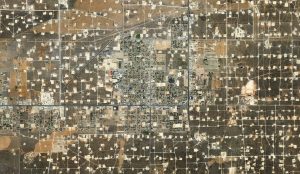I spoke to Mishka Henner standing in front of his large photographic print of the Wasson Oil and Gas field, Texas. At a distance the image looks for all the world like a computer circuit board, up close as you realise what it actually is, it involves you in its detail. Mishka, a young man with a young family, around him at the What’s in Store? exhibition private view, spoke earnestly about the work.
“This is the only oil field that has an urban centre; the others are in much more remote areas.”
In the centre of his composition there is an urban conurbation. One built on that typical American grid that was reduced so succinctly to coloured lines by Piet Mondrian in his later paintings. A grid of horizontal and vertical lines, but this circuit of human habitation has a virus.
“What,” I asked, “are all these white spots?”
“They’re the pump jacks. Under this there is a giant oil field and the nodding donkeys pump the oil out.”
The town is surrounded by them. White squares of concrete joined by thin white arterial roads. The parallel with the circuit board gets stronger, but so does the virus.
“There are pump jacks in people’s gardens, pump jacks outside the elementary school, outside the football stadium, there are thousands of pump jacks in this landscape.” He explained.
“To me the work is about the extent to which a landscape can be ravaged by an industry. How the thirst for a resource over takes all other environmental or health concerns.”
The landscape does look parched. My gaze was drawn in further. There are streets and roads in the city, the tracks to the pump jacks, but underneath these direct vertical and horizontal lines there are others, fainter, more haphazard.
“A lot of these,” said Mishka, “are pipelines. The aerial perspective reveals the excavations that have taken place.”
This man-made pattern drawn onto the landscape over time clearly has hidden depths and Mishka is on a mission to reveal them.
“Why I’m super interested in this is because the oil industry is so vast that it’s extremely difficult to create an image, a representation that encapsulates its processes and systems. Satellite imagery allows us to do that because it’s only once you’re 500 miles up in space that you can get a sense of the scale of it.”
I find myself considering the role of the contemporary artist. Here stitched together at pixel level the artist Mishka Henner gives us a view of something we otherwise cannot see. At one level it’s a mind-bogglingly vertiginous view of a contemporary American landscape, at another deeper level it’s a view of man’s exploitation of his environment, even more basically it’s a portrait of greed etched onto a parched canvas by hard graft.
“What I’ve never been able to work out,” Mishka mused, “Is where did this town start? Where is its oldest building? It seems like it has no centre.”
Realisation hits me.
“That’s because its heart is underground and it’s a black one.”
Satellite technology has enabled Mishka to construct this image. Yet for all its static pattern it is a living one. A capture of one moment, on one day.
“So somewhere in there as tiny, tiny dots, there will be people?” I ponder aloud
“People are smaller than a pixel, people are invisible in these pictures, they’re too small.”
Of course, viewed as a whole from space, we the architects of this landscape are no more than ants and our constructed purpose loses its meaning. There are parallels here with the Nazca lines, those incredible desert geoglyphs in Peru that only take on their true shapes, animals, birds etc. when viewed from the air. Those ancient Peruvian artists were creating images to be viewed by their gods. If the gods looked down today what would they make of the Wasson Oil field? No, this image isn’t a message for the gods, this is a message for us, a global warning of what we do to our world without even realising. Is that then one role for a contemporary artist? To appropriate technology and its imagery as a new medium to raise our awareness. Mishka Henner in his work has provided us with a means to see, here’s hoping that from seeing we can learn.
By Danny Morrell. June 2017.
